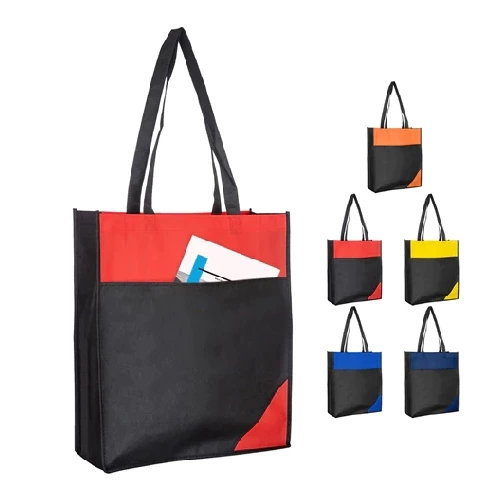What Are The Types Of Non-woven Environmentally Friendly Bags According To The Production Process?
Our common Non-woven Shopping Bag raw material is non-woven fabric, which is a new generation of environmentally friendly materials with the characteristics of moisture-proof, breathable, flexible, lightweight, non-combustible, easy to decompose, non-toxic and non-irritating, rich colors, low price, and recyclable. This material can be naturally decomposed in 90 days outdoors and has a service life of up to 5 years indoors. It is non-toxic, odorless, and has no residual substances when burned, so it does not pollute the environment. It is internationally recognized as an environmentally friendly product that protects the earth's ecology.
1. Spunbond non-woven fabric: Spunbond non-woven fabric is a non-woven fabric made by laying the filaments into a net after the polymer has been extruded and stretched to form continuous filaments. The fiber net is then self-bonded, thermally bonded, chemically bonded or mechanically reinforced to make the fiber net into a non-woven fabric. We often use non-woven environmental protection bags, non-woven packaging bags, etc., and they are also easy to identify because the rolling points of spunbond non-woven fabrics are rhombus-shaped. The non-woven environmental protection bags produced by Huanya Packaging Non-woven Bags Manufacturer use imitation bonded non-woven fabrics.
2. Heat-bonded nonwoven fabric: Heat-bonded nonwoven fabric refers to adding fibrous or powdery hot-melt bonding reinforcement materials to the fiber web, and the fiber web is then heated, melted, cooled and reinforced into cloth.
3. Pulp air-laid nonwoven fabric: Air-laid nonwoven fabric can also be called dust-free paper and dry papermaking nonwoven fabric. It uses air-laid technology to open the wood pulp fiberboard into a single fiber state, and then uses air flow to agglomerate the fibers on the web curtain, and then the fiber web is reinforced into cloth.
4. Wet-laid nonwoven fabric: Wet-laid nonwoven fabric is to open the fiber raw materials placed in the water medium into single fibers, and at the same time, mix different fiber raw materials to make fiber suspension slurry, which is transported to the web-forming mechanism. The fibers are formed into a web in a wet state and then reinforced into cloth.
5. Spunlace nonwoven fabric: The spunlace process is to spray high-pressure fine water flow onto one or more layers of fiber webs to entangle the fibers with each other, so that the fiber web can be reinforced and have a certain strength. The uses of spunlace nonwovens are medical curtains, surgical gowns, surgical drapes, medical dressing materials, wound dressings, medical gauze, aviation rags, clothing lining fabrics, coating fabrics, disposable materials, instrumentation rags, electronic industry rags, towels, cosmetic cotton, wet wipes, mask covering materials, etc.
6. Meltblown nonwoven fabric: The process of meltblown nonwoven fabric: polymer feeding---melt extrusion---fiber formation---fiber cooling---web formation---reinforcement into cloth.
7. Needle-punched nonwoven fabric: Needle-punched nonwoven fabric is a kind of dry nonwoven fabric. Needle-punched nonwoven fabric uses the puncture effect of needles to reinforce the fluffy fiber web into cloth. The production weight of needle-punched nonwoven fabric is generally above 100 grams, the fiber is coarse, the feel is rough, and there are small pinholes on the surface. Needle punching is generally thicker and can be used for geotextiles, geomembranes, velvet cloth, speaker blankets, electric blanket cotton, embroidery cotton, clothing cotton, Christmas crafts, leather base fabrics, and special fabrics for filter materials.
8. Stitched non-woven fabrics: Stitched non-woven fabrics are a type of dry non-woven fabrics. The stitching method uses a warp knitting coil structure to reinforce the fiber web, yarn layer, non-woven material (such as plastic sheet, plastic thin metal foil, etc.) or their combination to make non-woven fabrics.
9. Hydrophilic non-woven fabrics: Mainly used in the production of medical and sanitary materials to achieve a better feel and not scratch the skin. Sanitary napkins and sanitary pads use the hydrophilic function of hydrophilic non-woven fabrics.
Although there are many categories of non-woven fabrics, when choosing non-woven fabrics, you still have to choose them according to their corresponding characteristics, so that the role of non-woven fabrics can be played.
